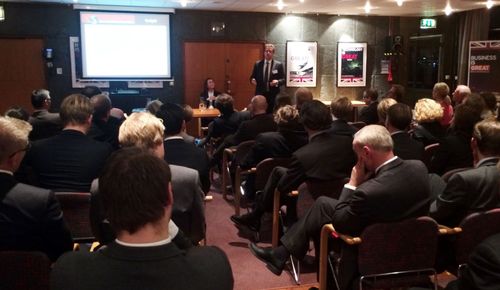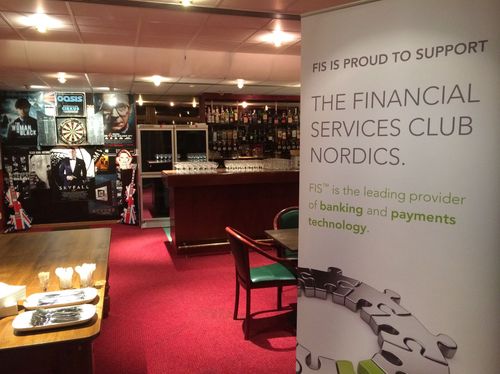
We had our first meeting of the Financial Services Club Nordic Region last week at the British Embassy in Stockholm.
Attended by around 70 senior figures from the financial markets across the region, we discussed the changes and implications of change in European investment markets, with a focus upon the processes involved in pre- and post- trade areas.
The panel consisted of three luminaries who could relate to the topic in depth:
- Peter Randall, founder and former CEO of Chi-X Europe;
- Olof Neiglick, founder and former CEO of Burgundy; and
- Hanna Vainio, Deputy CEO of Euroclear Finland / Head of Infrastructure division, Euroclear Finland and Euroclear Sweden

Peter kicked off proceedings and recounted the progress of MiFID and its impact on trading.
He illustrated this with a video that I found quite amazing.
The video shows just 10 seconds of trading.
It is slowed down immensely – about every 20 seconds watching the video is actually one second of real-time trading – and not only illustrates the volume and flow of orders, but the immense speed and therefore need for low latency.
The trading is in Blackberry stock on October 2nd, and the flows are from Nasdaq (top middle in Pink) in and out of other exchanges, as Nasdaq reroutes the orders to get best price.
If nothing else, it shows how technology has transformed the trading markets.
We talked a lot more about T2S, EMIR, MiFID2, Aquis, and ended with a prediction that the ever growing march of European harmonisation will create a single trading market in Europe over the next decade, and not one confined to transforming equities trading but all trading.
In other words, we have seen pre-trade equities trading transformed, we are now seeing post-trade clearing transformed. Soon, thanks to the regulatory regime on OTC Derivatives, we will see the Chi-X BATS effect in all area of the trading markets.
What is the Chi-X BATS effect?
It is the notion that things don’t change and then they do.
When MiFID (the Markets in Financial Instruments Directive) was first being debated, the main thrust of the dialogue was on the impact this would have on market makers.
Market makers would now be systematic internalisers, and would be subjected to much greater reporting and regulatory scrutiny.
The other debate was on best execution and what that meant.
Speed, price, cost and likelihood of settlement were all criteria being discussed and firms wondered how this would be implemented in practice.
One thing that was not debated was liquidity movement.
I remember distinctly that, at the time, everyone told me that liquidity didn’t leave.
Markets that had liquidity kept them and markets that tried to get liquidity would struggle because it doesn’t move.
Well that proved wrong.
According to Liquid Metrix, Chi-X has over 10% of liquidity in all European liquid share markets and around a quarter of all trading in the key ones of the FTSE (UK), CAC (France) and DAX (Germany).
In Sweden, the OMX is dominated by Chi-X BATS, whilst Burgundy has fallen to near irrelevance.
In other words, electronification of the trading arena drives liquidity away from the incumbent (usually the national exchange, CSD and CCP) and toward the new entrant who has the technology operation to compete effectively.
As Peter pointed out, Euronext has around €2 million turnover per member of staff compared to over €50 million in Chi-X BATS.
All in all, it made me realise that for all the debate about the inefficiencies of retail banking, it is the wholesale markets that are driving competitive efficiency effectively. Retail is way too protected by comparison.
Anyways, the meeting finished by retiring to the British Embassy’s very own pub The Pickled Herring.

Nothing like exporting some British taste around Europe is there?
Chris M Skinner
Chris Skinner is best known as an independent commentator on the financial markets through his blog, TheFinanser.com, as author of the bestselling book Digital Bank, and Chair of the European networking forum the Financial Services Club. He has been voted one of the most influential people in banking by The Financial Brand (as well as one of the best blogs), a FinTech Titan (Next Bank), one of the Fintech Leaders you need to follow (City AM, Deluxe and Jax Finance), as well as one of the Top 40 most influential people in financial technology by the Wall Street Journal's Financial News. To learn more click here...

